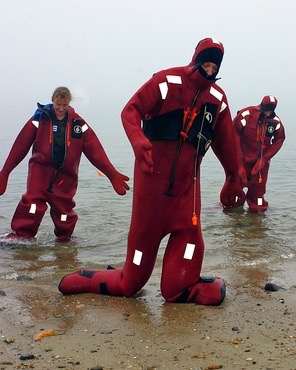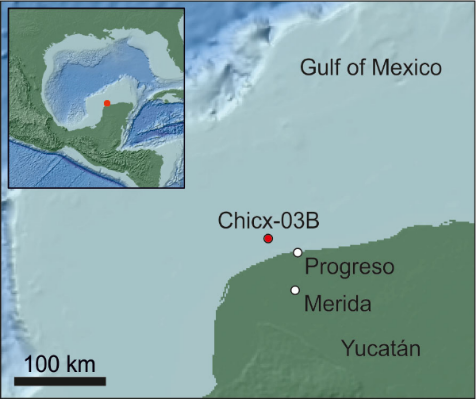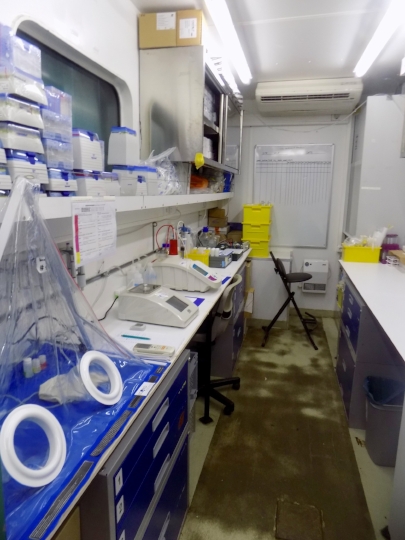A couple months ago, I was lucky enough to have a really unique and amazing experience aboard the Liftboat Myrtle with scientists who were drilling into the Chicxulub Impact Crater. Here is a behind-the-scenes look at what that was like for me.
How did you get to be on that ship?
There’s no way this would have happened if I had not applied in 2009 to be one of the educators to participate in the School of Rock on the JOIDES Resolution. “School of Rock” is kind of like a summer camp for educators, except you’re living on a boat at sea and, instead of making wallets and hanging out in the infirmary because you got poison ivy, you make smear slides and hang out in the infirmary because you got seasick. School of Rock allows educators to learn from seafloor scientists about how scientists study the seafloor. They also get to use the same superfancy lab equipment the scientists use on the JOIDES Resolution.
I was lucky enough to be picked to be one of the participants in the 2009 School of Rock. I was fascinated by everything we learned and experienced and, ever since then, I have been teaching people about the JOIDES Resolution and its research. (I even wrote a couple of free eBooks about it).
The JOIDES Resolution is operated by the International Ocean Discovery Program (IODP), which is a scientific organization that drills the seafloor to collect core samples to learn more about the Earth. The IODP is also in charge of the Chixculub Impact Crater expedition. When I heard scientists would be drilling into the Chixculub Impact Crater for the first time ever, I told the U.S. education and outreach program for the IODP that I would love to do outreach for the expedition. At the time I asked, I thought the likelihood of this happening was about the same as me becoming the star of a sitcom on the Disney Channel, but somehow it all worked out and I was able to be part of the expedition for a few days.
What did you have to do to prepare to join the expedition?
I had to wear an outfit like this...
...and jump into a swimming pool wearing it. I’m not kidding.
The drilling of the Chicxulub Impact Crater was being done on the Liftboat Myrtle.
The Liftboat Myrtle
Before anyone can stay overnight on the Liftboat Myrtle, that person is required to be trained in personal sea survival. Basically, this training tells you the best ways to prevent your own death if the ship sank, which is a fun way to spend a couple days.
Since I live about five hours from the ocean, to take a class about surviving in the ocean, I had to go to a school near the ocean. So I flew to New York City to train at Maritime College in the Bronx.
For part of the training we got to watch encouraging videos like this:
We also went to a pool and put on survival suits. (Unfortunately, I don’t have any photos of me from the training, but if you want to see a video of me putting on a survival suit on the JOIDES Resolution and then, for some reason, doing the Robot, go here.)
Survival suits are also called “Gumby suits” because they make you look like the stop-motion animation character from the 1960s named “Gumby”...
...except you’re bright orange instead of green.
If you are ever stuck swimming in the middle of the ocean, wearing a survival suit will keep you relatively warm and dry and also make it easier to float. They’re not the easiest things to put on, though, so it helps to practice before your ship sinks.
At the training, once we had our survival suit on, we practiced how to jump into water wearing one.
We also practiced how to link together in the water to help each other survive in case there were no lifeboats or other floating objects around to hold onto.
We even practiced how to flip an upside-down, inflatable life raft right-side up.
Though none of these photos show me, I had to do all these same things in this same pool. These three images are from Maritime College's Facebook page.
I passed the survival course as well as a medical exam and was then able to join the expedition for a few days.
How did I get to the ship?
The expedition was drilling in the Gulf of Mexico right near the Yucatan Peninsula.
To get there, I flew to Merida, Mexico where I stayed in a hotel until I was able to board the ship.
Merida is actually in the Chicxulub Crater, but the asteroid impact occurred so long ago that the crater is pretty much all filled in now. So instead of looking across from my hotel and seeing this:
I looked across from my hotel and saw this:
I was only on land for a little over a day. The drillsite was close enough to shore that they were able to send a boat out to it once or twice a week to bring supplies, reporters and the occasional outreach educator back and forth from the ship. I was able to board the transport boat shortly after arriving in Mexico.
You could not see the Liftboat Myrtle from shore, but when we got near enough to it on the boat, seeing this ship-on-stilts appear on the horizon was kind of like that scene in the original Star Wars (aka Chapter IV: A New Hope) when the Millennium Falcon jumps out of hyperspace and Luke, Han, Obi-Wan, and Chewbacca see the Death Star for the first time ever, except the Liftboat Myrtle had not recently blown up the planet Alderaan.
This is not the most expertly taken panorama shot ever, but still, there’s the Liftboat Myrtle on the horizon.
The deck of the Liftboat Myrtle is about 40 feet in the air. So to get up to it from our transport boat we had to be lifted by a crane in a basket (You can see a sped-up video of this happening here).
This basket's safety restraints are your ability to hold onto two cables that stretch from the floor to the top of the basket, as well as the crane operator’s ability not to jerk you all over the place. There are restraining nets on it, but those are for your luggage.
The first time I rode in the basket, I had a death grip on those cables and spent the entire time staring at the pole in the middle of the basket, because I was too nervous to look anywhere else. The second time I did it, I was able to relax a little more and actually enjoy the view it gave me.
What did you do on the ship?
First, I was issued this outfit:
...that I had to wear almost the entire time I was on the Liftboat Myrtle. For safety reasons we were each issued a hardhat, coveralls, and steel-toed boots to wear anytime we were in the drill floor area. That way if something fell on us or if we fell on something on the drill floor, we were less likely to need to be airlifted to a hospital. The drill floor was where all the action was, so I wore this outfit a lot. Unfortunately, I was on the ship in May and the drill site was not that far from the Equator, so this was a very sweat-inducing ensemble.
I was part of the expedition mainly to let the public know what the scientists were doing on the ship. One of the ways I did this was by giving live, interactive video tours to schools via the internet. That’s why I’m holding that laptop in the photo.
My stay on the ship was much too short.
On my last day I was literally taken out with the trash. When I took this photo, I was standing on the transport boat waiting for that big, white bag of garbage to be lowered on deck with us before we headed back to shore.
I was there from just a Tuesday to a Friday, and I would have happily stayed longer. But I still managed to learn a great deal, meet some wonderful people from all over the world, and have an amazing experience I will never forget!
But, wait! What about the scientists? What were they doing on the ship?
I was also part of the Chicxulub Impact Crater to talk to the scientists so I could find out more about what they were hoping to learn about the Chicxulub impact and its aftermath and how they were going about learning it.
Here’s the scientists who were with me on the Liftboat Myrtle.
The scientists came from a lot of different places in the world, as you can see below from these signs they made one day when they were feeling extra creative. The signs show where each of the scientists came from.
The Liftboat Myrtle is not actually a drilling ship, much less a scientific drilling ship. For the scientists to be able to use it, the ship had to be modified for this expedition. The drill was temporarily pinned and welded to the side of the ship.
That tall thing in the middle is the drill.
So when the engineers and drillers were working the drill...
...they were standing on this platform with its clear ocean views:
There normally are not any lab spaces on the Liftboat Myrtle either, so these things below that look like Porta Potties...
...are containers that were put on the deck to act as temporary labs and offices for the scientists.
Inside one of those containers.
When the cores came up...
...the scientists did some initial observation and data recording, but they did not have all the lab equipment they needed to fully describe each core. So the cores were stored in a refrigerated container...
Behind these scientists is the refrigerated container where the cores were stored on the ship.
...and when the expedition was over, all the cores were shipped to Germany to be stored in a repository (kind of like a library for cores).
In September, the entire science team will come together to use lab equipment near the repository to cut all of the Chicxulub Crater cores in half and start observing and describing them in earnest.
And I will also be shipped off to Germany so I can join the scientists and again provide education and outreach about what they are doing! To see how you can follow along, visit my Chicxulub Impact Crater page .
To learn more about scientific ocean drilling, read my free eBook Uncovering Earth’s Secrets.
Online References and Resources:
ECORD. "Expedition 364 Chicxulub K-Pg Impact Crater."
http://www.ecord.org/expedition364/
The JOIDES Resolution website. "Expedition 364: Chicxulub K-Pg Impact Crater"
http://joidesresolution.org/node/4531
Kevin Kurtz website. "Chicxulub Impact Crater Expedition."
http://www.kevkurtz.com/dinosaur-crater-of-doom/
Photos and Images:
Click the photos and images used above to find their sources. If the photo does not link anywhere, it was taken by Kevin Kurtz, unless, of course, it has Kevin Kurtz in it. If the photo shows a bunch of people with the title "School of Rock," it was taken by Bill Crawford. If the photo shows Kevin in a Gumby suit, it was taken by Lisa Strong. If the photo shows Kevin holding a laptop and wearing coveralls, it was taken by Mary Mowat.

























